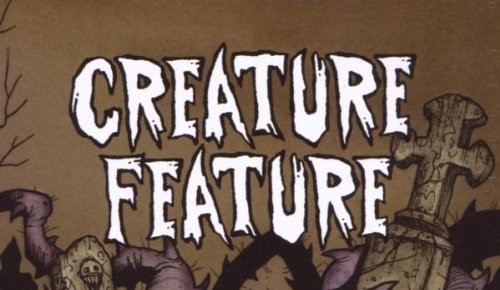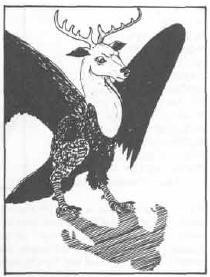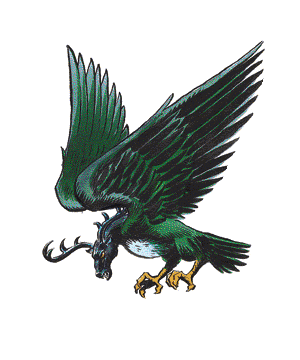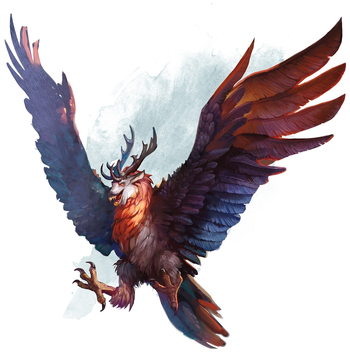
There have been a lot of monsters published in the Dungeons and Dragons game through the years, so many that cataloging them all would be a terribly arduous task. And with so many selections to choose from, a DM can be easily forgiven for missing some unique and downright cool monsters. And that is what this segment is hoping to address – by highlighting individual creatures and doing a deeper dive into their lore (both in game and in any mythologies or legends from our world) as well as taking a look at any fun tricks they have in their stat blocks. Hopefully you’ll come away with a desire to use these creatures for the first time, or in new and interesting ways.

The Peryton was described by early 20th century writer Jorge Luis Borges in his Book of Imaginary Beings in 1957, supposedly using a long-lost medieval manuscript. In this book, he described a creature that combined the physical features of bird and stag. According to Borges, the Peryton was a creature that dwelled in the lost city of Atlantis until an earthquake drove them to take flight and flee. These creatures were reputed to cast the shadow of a man until they killed one in their own lifetime, after which they would cast their own shadow.
The peryton first appears in Dungeons and Dragons in the original 1977 Monster Manual and have appeared in almost every edition of the game (though not in 4th Edition), keeping a similar look through their various appearances – the head and antlers of a stag and the hindquarters, body and wings of a large bird of prey. Omnivorous, the peryton could survive on vegetation and game animals, but preferred humanoid flesh, and especially the heart, which they would tear out of their victims and eat fresh. It’s said that after they consume a fresh heart, their shadow reverts from a human to their true monstrous form for a time.

Some scholars believe they are driven by an internal desire to consume these hearts, and that they believe they may be able to ascend to a higher form of existence when they eat the correct one. In fact, this process of feasting on fresh hearts is imperative for the reproduction of these creatures, with the female only becoming fertile after feasting on the fresh heart of a humanoid. When fertile, she can lay a clutch of one to four eggs, whose shells are hard as metal. These clutches would be incubated for a month, after which the newly hatched perytons were raised until they reached maturity, leaving to establish their own nests around 1 year of age.
These nests are built in carefully selected locations in order to minimize competition from both other perytons and other winged creatures, favoring high mountain caves and ridges where they have easy access to the vales and mountain roads for hunting. Creatures of evil and chaos, they do not typically get along with one another, leading to small groups and family units of two to eight being most common.
These hunters do not give up once they have sighted prey, attacking from surprise quickly and tenaciously stalking foes that manage to escape or drive it off. There is no subtlety in their attacks – these creatures try to ambush foes and then tear them to pieces with their razor sharp horns and claws, using their winged mobility to attempt to stay out of reach of their prey, and relying on their supernaturally toughened hide to protect them if forced into melee combat.

Several theories have been put forth as to the creation of these clearly unnatural and magical beasts. In the Forgotten Realms, the common belief is that they were created by an evil deity. It is also a possibility that they were created by the alhoon mage known as the Beast Lord, an ally of the Zhentarim in the north.
Another theory states that these creatures were once a race of humans known as the Khala of Imaskar, who worshipped the evil deity Bane. As punishment for their crimes, they were cursed by the five gods of law – Lathander, Mystra, Torm, Ilmater, and Mielikki into their current forms.
Yet others whisper of a darker and more sinister origin for these foul creatures, a tale favored by certain bards with a flair for dark campfire tales. It tells of a woman, whose name has been lost to time, who was humiliated when her husband was discovered with a younger lover. Seeking revenge, the scored wife murdered her rival and consumed her heart in a ritual that caused her husband to desire her and her alone for the rest of his life. While the ritual succeeded, her dark deeds were eventually discovered by the rest of the village. After she was hanged for her crimes, it is said that the dark magics she dabbled with caused the carrion birds that feasted on her flesh to turn into the first perytons.
Regardless of where they came from, it is safe to say that the world was made less safe for having them in it.
As hinted at above, the peryton carry a natural resistance to any attacks made by nonmagical slashing, piercing, or bludgeoning weapons. They also have several abilities that key off of their flight ability. The first is a Dive Attack which deals extra damage. The peryton is able to strike from above and moves at least 30 feet. The second ability is known as Flyby and it allows the peryton to fly through an enemy’s reach without provoking an attack of opportunity, allowing it to wheel back around for another devastating dive attack. At a CR 2, these creatures are nothing to be trifled with, and several of them defending their nests with ample room for them to maneuver could spell trouble for even seasoned adventurers that aren’t equipped to deal with flying monsters.
